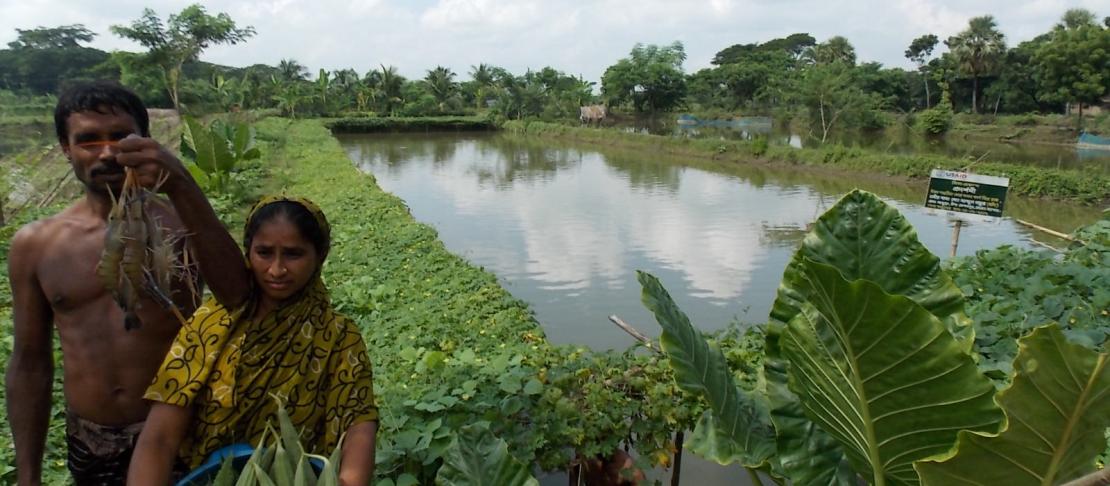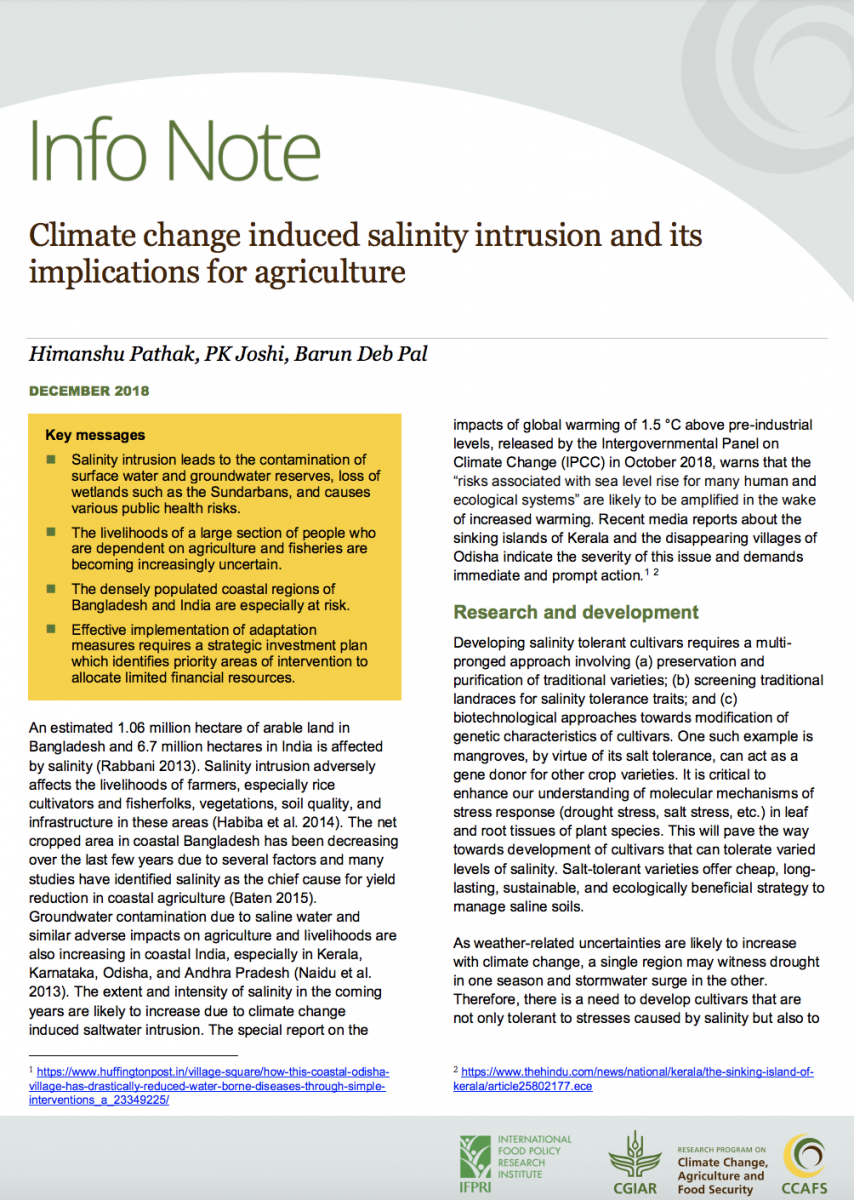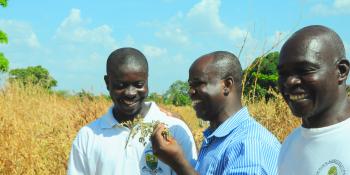Learning about the impact of salinity intrusion on agriculture in South Asia

At a recent meeting, stakeholders exchanged knowledge about climate change induced salinity intrusion and its implications for agriculture in Bangladesh and India.
Salinity intrusion is leading to contamination of surface water and groundwater reserves, loss of wetlands, and causing various public health risks. It makes the livelihoods of a large section of people, who are dependent on fisheries and agriculture, increasingly uncertain.
It will take a multi-sectoral approach to adapt to salinity intrusion, and the costs of response measures could be immense. Therefore, effective implementation of adaptation measures requires a strategic investment plan which identifies priority areas of intervention to allocate limited financial resources.
The densely populated coastal regions of Bangladesh and India are especially at risk. This is why the International Food Policy Research Institute (IFPRI), in collaboration with the CGIAR Research Program on Climate Change, Agriculture and Food Security (CCAFS) and the Borlaug Institute for South Asia (BISA), organized a one-day stakeholder meeting on climate change induced salinity intrusion in coastal Bangladesh and India on December 18, 2018.
A platform for knowledge exchange
The meeting focused on
- the impact of salinity intrusion on livelihoods, crop production, and other agricultural systems, aquatic ecosystems, and infrastructure;
- various adaptation methods and techniques currently adopted by different stakeholders and the scope for further upscaling; and
- the best practices across regions, including the constraints and opportunities for knowledge transfer across the international border with similar agro-climatic conditions.
Read the related info note: Climate change induced salinity intrusion and its implications for agriculture
The meeting served as a platform for interaction and cross-learning for scientists, researchers, and other stakeholders to discuss research results and scope for policy interventions. The underlying themes for discussion were adaptation techniques with respect to water management, crop management, and livelihood security.
Dr. A K Singh, Deputy Director General of the Indian Council of Agricultural Research (ICAR), lauded IFPRI’s efforts to initiate discussion on the impacts of salinity intrusion. He emphasized the need to develop a coordinated strategy for the future as the area under salinity is going to increase due to climate change.
Dr. Wais Kabir, Executive Director of Krishi Gobeshona Foundation, discussed the seasonal nature of salinity in coastal Bangladesh that requires adjusting cropping patterns accordingly.
Dr. Sheetal Sharma from the International Rice Research Institute (IRRI) discussed the role of information and communications technology-based tools to disseminate timely and accurate information to cultivators to facilitate decision making. These tools can be used to broadcast customized advisories with respect to nutrient requirement, fertilizer use, stress forecasting, etc.
Emerging suggestions for future research and policy recommendations from the meeting emphasize the adoption of a multi-sectoral approach to minimize the risks posed by salinity intrusion. These include:
- The three main categories of adaptation measures – technological solutions, management practices, and institutional capacity – provide a workable starting point towards building long-term strategies related to climate change induced salinity intrusion.
- There is a need to develop multi-stress tolerant cultivars, in addition to the existing salt-tolerant varieties, in the wake of increased weather uncertainties due to climate change.
- The exercise of varietal development shall go hand-in-hand with salinity mapping of coastal areas for promoting soil health. This can help in assessing the location-specific needs of cultivars according to the concentration and nature of salinity.
- Water is vital to agriculture, and the success of climate-smart agriculture (CSA) depends on the availability and management of freshwater in coastal areas. An integrated water resource management approach must be adopted to reduce the stress on available resources and prevent them from contamination.
- Improved Doruvu technology has proved to be an efficient technology in coastal Andhra Pradesh in India. The limitations of Doruvu technology, especially its limited applicability in sandy regions, must be further studied for its upscaling.
- Sluice gates hold the key to contain salinity, and at the same time, the operation of sluice gates is a reason for conflicts due to clashing interests of people engaged in rice farming and shrimp farming. Therefore, community management of sluice gates in a mutually beneficial manner is vital to adapt to salinity intrusion. It has the potential to optimize the interests of people in that area. Many polder regions in Bangladesh are using this opportunity to efficiently manage the water flow.
- Farmers’ organizations should be formed based on catchment area and hydrological limit of sluice gates rather than the administrative limits, as is done currently in most areas.
- The scope of application of eco-technological concepts such as Tidal River Management (TRM) can be explored in areas where natural flows are suitable.
- Any new intervention for the farmers in the coastal region must be studied from the cost-benefit perspective from upstream to downstream for a comprehensive risk assessment. Similarly, issues related to the strengthening of grassroot-level institutions and gender roles must be incorporated at the project stage itself to ensure the sustainability of new interventions.
- Non-availability of labor for agricultural activities is one of the major constraints in salinity affected areas. This is due to migration and overlap of public programs with the cropping season. Although Bangladesh achieved substantial growth in mechanization to replace animal labor, more emphasis must be given on human labor substitute mechanization for crop cultivation.
- There is a need for immediate, coordinated, and a recursively dynamic approach towards policymaking in coastal Bangladesh and India to safeguard the livelihoods of millions of people living in these regions.
Next steps
The challenge posed by salinity intrusion can be made as an opportunity to sustainably enhance agricultural and aquacultural productivity and, consequently, the incomes of people living in these regions. IFPRI will continue its collaboration with CCAFS in the second phase of the project to evaluate alternative policies and institutions and develop investment plans to adapt to climate change. It is aimed to develop investment prioritization models, and future climate action plans to tackle the adverse effects of salinity intrusion.
Read more:
Himanshu Pathak is a Research Analyst at the International Food Policy Research Institute. Barun Deb Pal is a Project Manager at the International Food Policy Research Institute. Pramod K. Joshi is the Director for South Asia at the International Food Policy Research Institute.




